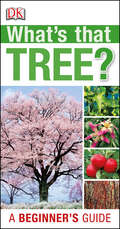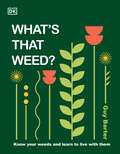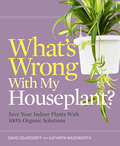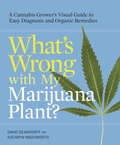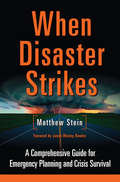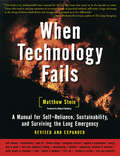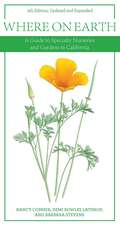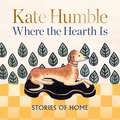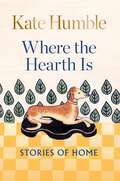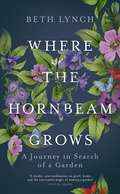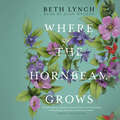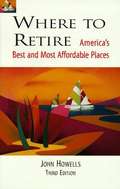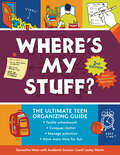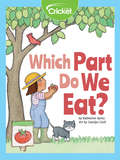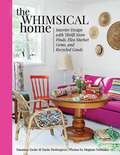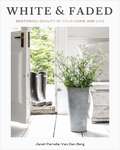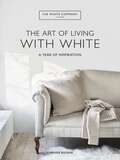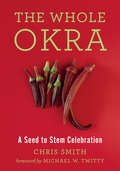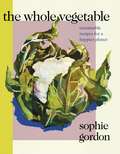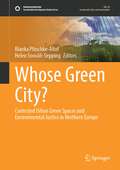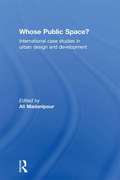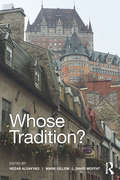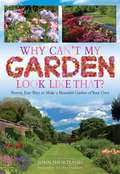- Table View
- List View
What's that Tree?: A Beginner's Guide (DK What's That?)
by DKLearn more about the beautiful trees around you with this identification guide, perfect for beginners, featuring over 150 common tree species. If you want to know the difference between a Serbian spruce and a silver birch or how different trees change through the seasons then What&’s that Tree? is the ideal guide for you. Species overviews show you what to look for where and related trees are shown side by side for quick comparison and identification.Clear photography of leaves will help you to directly compare the tree you&’re looking at with those in the guide and will assist you with specific features of the leaf to help identify the tree. This quick-reference guide also includes information on bark, flowers, and seeds. The perfect pocket guide for beginners but also a handy reference for the more seasoned naturalist, What&’s that Tree? will help you to become an expert tree-spotter in no time.
What's That Weed?: Know Your Weeds and Learn to Live with Them
by DKLearn all about common weeds and how they affect your garden to make informed decisions about the plants you want in your patch - and how to manage those that you don't.Figuring out which weed is which can be tricky for new and seasoned gardeners alike. In this book, garden expert Guy Barter lifts the lid on how weeds grow and in what conditions. Discover each weed's benefit to wildlife, biodiversity, and its role in the environment - plus whether it has ornamental, herbal, or edible properties that you might want to make the most of.This identification guide covers 40 weeds commonly found in gardens in Europe and North America. Alongside well-known weeds such as nettles, dock, dandelions, and bindweed, you'll find hawksbeard, pearlwort, ivy-leaved speedwell, and pennycress.In this book, you will find: -Detailed photographs and diagrams of each element of the plant, from roots to leaves-Specific tools to help you recognize weeds throughout their entire life cycles, from starting out as seedlings before growing into mature flowers.-The best way to manage each weed and curate the perfect plants for your patch.-Each weed's place within the ecosystem is listed, along with benefits, such as use as an ornamental, herbal, or edible plant-Every element of the 40 weeds along each stage of their life cycle, enabling clear identification for gardeners.With this guide, you can identify plants and understand more about weeds and roots and their benefits.The perfect title for seasoned gardeners who are looking to identify, manage, and control the weeds in their gardens or new gardeners who are keen to learn about and identify the existing plants in their gardens.
What's Wrong With My Houseplant?: Save Your Indoor Plants With 100% Organic Solutions (What’s Wrong Series)
by David Deardorff Kathryn WadsworthThis book will turn even the brownest thumbs green! Houseplants add style, clean the air, and bring nature indoors. But they are often plagued with problems—aphids, mealybugs, mites, and thrips to name just a few. What’s Wrong With My Houseplant? shows you how to keep indoor plants healthy by first teaching you how to identify the problem and solve it with a safe, natural solution. This hardworking guide includes plant profiles for 148 plants organized by type with visual keys to the most of common problems, and the related organic solutions that will lead to a healthy plant.
What's Wrong with My Marijuana Plant?: A Cannabis Grower's Visual Guide to Easy Diagnosis and Organic Remedies
by David Deardorff Kathryn WadsworthA simple step-by-step system for identifying, repairing, and preventing problems with marijuana plants.What's Wrong with My Marijuana Plant? is the first problem-solving book for marijuana growers with an effective and easy-to-use visual diagnostic system pioneered by Deardorff and Wadsworth for identifying pest, disease, and environmental problems by symptom. What are those rusty spots on your leaves? What bug is eating your buds? Why are your sativa sprouts covered in fuzz? Find out fast AND learn how to fix it! This book contains all-organic solutions (vitally important to protect your health, the health of your plants, and the environment) plus best growing practices to avoid problems before they start. Written in easily understandable, non-technical language and heavily illustrated with precise photography to allow rapid and accurate diagnosis, this is an essential resource for beginning and experienced growers alike.
When Disaster Strikes
by Matt SteinThis well written guide provides instruction on making sure your needs are met for food, water, first aid and self-defense in any crisis. Specific instructions for handling seven types of disasters, from fire and earthquakes to electromagnetic pulses and solar storms are provided. Useful figures appear throughout, and the book closes with recommended reading and resources. Stein is an avid outdoorsman and green builder. Annotation ©2012 Book News, Inc. , Portland, OR (booknews. com)
When Technology Fails
by Matthew SteinThere's never been a better time to "be prepared. " Matthew Stein's comprehensive primer on sustainable living skills-from food and water to shelter and energy to first-aid and crisis-management skills-prepares you to embark on the path toward sustainability. But unlike any other book, Stein not only shows you how to live "green" in seemingly stable times, but to live in the face of potential disasters, lasting days or years, coming in the form of social upheaval, economic meltdown, or environmental catastrophe. "When Technology Fails" covers the gamut. You'll learn how to start a fire and keep warm if you've been left temporarily homeless, as well as the basics of installing a renewable energy system for your home or business. You'll learn how to find and sterilize water in the face of utility failure, as well as practical information for dealing with water-quality issues even when the public tap water is still flowing. You'll learn alternative techniques for healing equally suited to an era of profit-driven malpractice as to situations of social calamity. Each chapter (a survey of the risks to the status quo; supplies and preparation for short- and long-term emergencies; emergency measures for survival; water; food; shelter; clothing; first aid, low-tech medicine, and healing; energy, heat, and power; metalworking; utensils and storage; low-tech chemistry; and engineering, machines, and materials) offers the same approach, describing skills for self-reliance in good times and bad. Fully revised and expanded-the first edition was written pre-9/11 and pre-Katrina, when few Americans took the risk of social disruption seriously-"When Technology Fails" ends on a positive, proactive note with a new chapter on "Making the Shift to Sustainability," which offers practical suggestions for changing our world on personal, community and global levels.
Where on Earth: A Guide to Specialty Nurseries and Gardens in California
by Nancy Conner Barbara Stevens Demi LathropEver since its initial publication in 1993, this guide to California's specialty plant nurseries has been an invaluable tool for gardeners and landscapers, and it is now available in an expanded and completely revised edition. Organized by geographic region, each listing provides essential information, including address, contact information, hours, plant offerings, and a detailed description of the facility and its owners. In addition to featuring specialty nurseries, Where on Earth catalogs notable garden centers, plant societies, education programs, and horticultural attractions throughout the state, as well as mail-order sources for bulbs, seeds, and rhizomes. The coauthors also include twelve essays, one for each region, that address that area's special features and gardening concerns. Whether you're searching for antique roses on the foggy North Coast, water-wise succulents and native shrubs around Los Angeles, or a palm doctor for your sickly cycads in the Central Valley, this book gives current, detailed advice for plant lovers to see, shop, and savor.
Where the Hearth Is: Stories of home (Kate Humble)
by Kate HumbleKate Humble has a knack for sharing her own journey towards a more pleasing and purposeful life in a way that inspires readers, enables them to reassess their own lives and helps them achieve their personal goals. Having encouraged readers to reconnect with nature in Thinking on My Feet and simplify their lifestyles in A Year of Living Simply, she turns now to reimagining the ideal home - examining her own experiences and expectations, considering all the elements necessary to futureproof her home life, taking advice from others living uniquely, extraordinarily, happily, and gaining insights from some unexpected quarters - including the animal kingdom.As our time spent in office buildings and other traditional workplaces shrinks forevermore, feeling happy, healthy, productive and content in our homes (be they castles or caravans, flat-shares or farms, fixed or temporary, inner city/out of town/beyond) is more important to get right than ever before. Where the Hearth Is will resonate with all those seeking to make the most of their lives during the many hours we all spend at home - whether it's a case of tiny adjustments while staying put, moving out, living differently or dreaming of building something new.
Where the Hearth Is: Stories of home (Kate Humble)
by Kate HumbleKate Humble has a knack for sharing her own journey towards a more pleasing and purposeful life in a way that inspires readers, enables them to reassess their own lives and helps them achieve their personal goals. Having encouraged readers to reconnect with nature in Thinking on My Feet and simplify their lifestyles in A Year of Living Simply, she turns now to reimagining whatever we consider 'home' - examining her own experiences and expectations, ideals and memories, and considering the views of others living uniquely, extraordinarily, happily. She's gaining insights from some unexpected quarters - including the animal kingdom.As our time spent in office buildings and other traditional workplaces shrinks forevermore, feeling happy, healthy, productive and content in our homes (be they castles or caravans, flat-shares or farms, fixed or temporary, inner city/out of town/beyond) is more important to get right than ever before. Where the Hearth Is will resonate with all those seeking to make the most of their lives during the many hours we all spend at home - whether it's a case of tiny adjustments while staying put, moving out, living differently or dreaming of building something new.
Where the Hornbeam Grows: A Journey in Search of a Garden
by Beth Lynch'Beth Lynch's subtle and moving book is about the heart-work of finding and making a place for oneself in the world; the effort of putting down roots, the pain of tearing them up again, and how one grows to know another person or another landscape. Horticulture and human feelings twine together here - and what flourishes in the several gardens of this book is, in the end, hope' ROBERT MACFARLANE'I loved Beth Lynch's tender, wise meditation on grief, home, and the restorative magic of making a garden' OLIVIA LAINGOut of place and lonely after a relocation to Switzerland, Beth Lynch realises that she needs to get her hands dirty if she is to put down roots. And so she sets about making herself at home in the way she knows best - by tending a garden, growing things. The search for a garden takes her across the country, through meadows and on mountain paths where familiar garden plants run wild, to the rugged hills of the Swiss Jura where she begins to plant her paradise. WHERE THE HORNBEAM GROWS is a memoir about carrying a garden inwardly through loss, dislocation and relocation, about finding a sense of wellbeing in a green place of one's own, and about the limits of paradise in a peopled world. It is a powerful exploration of how, in nurturing a corner of the natural world, we ourselves are nurtured.
Where the Hornbeam Grows: A Journey in Search of a Garden
by Beth Lynch'Beth Lynch's subtle and moving book is about the heart-work of finding and making a place for oneself in the world; the effort of putting down roots, the pain of tearing them up again, and how one grows to know another person or another landscape. Horticulture and human feelings twine together here - and what flourishes in the several gardens of this book is, in the end, hope' ROBERT MACFARLANE'I loved Beth Lynch's tender, wise meditation on grief, home, and the restorative magic of making a garden' OLIVIA LAINGOut of place and lonely after a relocation to Switzerland, Beth Lynch realises that she needs to get her hands dirty if she is to put down roots. And so she sets about making herself at home in the way she knows best - by tending a garden, growing things. The search for a garden takes her across the country, through meadows and on mountain paths where familiar garden plants run wild, to the rugged hills of the Swiss Jura where she begins to plant her paradise. WHERE THE HORNBEAM GROWS is a memoir about carrying a garden inwardly through loss, dislocation and relocation, about finding a sense of wellbeing in a green place of one's own, and about the limits of paradise in a peopled world. It is a powerful exploration of how, in nurturing a corner of the natural world, we ourselves are nurtured.
Where to Retire: America's Best and Most Affordable Places
by John HowellsIn this well-researched guide, the author gives the best advice not only on where to relocate in your retirement years, but why you should pick up and move just as life is settling down. The books presents clear snapshots of life in hundreds of the most affordable, comfortable, and stimulating places to retire in the US.
Where's My Stuff? 2nd Edition: The Ultimate Teen Organizing Guide
by Samantha Moss Lesley MartinA comprehensive guide for young adults on how to organize schoolwork, lockers, bedrooms, and even schedules. Take a quiz to identify your organizing style and get great advice about making decisions, purging closets, and creating the perfect space to relax, work, and store belongings. With fun and useful illustrations, easy-to-follow charts, and ample doses of humor, Where's My Stuff? is an incredible asset for anyone who wants to get it together and keep it together, for good. Newly updated for readers living in a digital world, this 2nd edition includes tips on managing online files and backups, digital planners, and more. Written in collaboration with professional teen organizer Lesley Martin.
Which Part Do We Eat?
by Katherine Ayres Carolyn CrollHave you ever walked through a garden and wondered which part of a fruit or vegetable you’re supposed to eat? It could be the pod, the leaves, the seeds, the root, or even the flower! Follow along with this poem to learn about fresh, tasty veggies!
The Whimsical Home: Interior Design with Thrift Store Finds, Flea Market Gems, and Recycled Goods
by Susanna Zacke Sania HedengrenVintage clothing, vintage décor--it simply never gets old and continues to be one of the hottest style trends! Now, you too can create a beautiful vintage home environment that is sure to be the envy all your peers. In The Whimsical Home, master crafters Sania and Susanna show us five different homes furnished with different vintage pieces. Each chapter ends with tips to achieve these fun and whimsical looks. And the best part? None of these exquisite looks will cost you an arm and a leg. Chances are you probably already have a lot of key pieces just lying around your home. Sania and Susanna will show you exactly how to use them. Crafts include: Concrete candle holders A stool decorated with domino pieces A picture made of potholders Follow Sania and Susanna as they travel from home to home, casting in concrete, crocheting, sewing, building, painting, and revamping. Learn how to mix and match unique flea-market finds with modern furniture, and how to reuse old trinkets you may have lying around your house. Be inspired by Sania and Susanna’s expertise and advice. Let your imagination run wild; the sky is the limit. Your house will be beautiful, unique, and the envy of homeowners everywhere.
White and Faded: Restoring Beauty in Your Home and Life
by Janet Parrella-Van Den BergThe only thing more beautiful than home transformation is personal transformation. Bring new life into your home and your soul through the gorgeous photography, inspiring story, and creative design ideas from Janet Parrella-Van Den Berg, founder of popular UK brand White & Faded. Journey through these hope-filled pages, and discover the hidden beauty in your own home and life.In White & Faded, Janet Parrella-Van Den Berg takes you on a stunning photographic tour through her restored English homes as she invites you into her personal journey of restoring her own sense of value and purpose—and reveals how you can do the same.So what is White & Faded? As Janet explains, she loves white things as a culmination of all colors and a representation of new mercies. And she loves faded things, such as cast-aside furniture, as a reminder that even what is painful or imperfect can be repurposed to reveal hidden beauty. Janet gives insights into both the literal and metaphorical aspects of white and faded as she draws on her decades of experience to offer:Full-color photography of restored English country homes, including a 1767 Georgian rectory in Kent and a home originally built in 1500Practical restoration tips—from large-scale homes to smaller antiquesFresh decorative ideas you can adapt to your own style, home, and season of lifeFun inspiration—from antique to modern—ideal for fans of HGTV and Magnolia NetworkInspiration to incorporate a touch of seasonal charm throughout the yearHow to make white work with kids and pets Janet's own remarkable story of trauma, love, and rediscovered identity How will you create a place in your life where you feel loved, find healing, and discover new treasures? Sometimes seeing the past through new eyes gives hope for the future—and looking ahead can be a beautiful way to come home.
The White Company The Art of Living with White: A Year of Inspiration (White Company)
by Chrissie Rucker Company'I love a home to feel warm, inviting, personal and lived-in - and mastering how to decorate with white and neutrals is a wonderful way to achieve this.''- CHRISSIE RUCKERIn her much-anticipated second book, The Art Of Living With White, Chrissie Rucker, Founder of The White Company, explores 10 inspirational homes that illustrate beautifully different ways to use white and neutrals through the seasons. The homes vary in size, style and location - from a minimalist city pied-à-terre to a New England-style country house - but what unites them all is the welcoming, stylish and calm feel that their owners have each created.The homes are grouped into the four seasons and each chapter ends with a summary of seasonal rituals that will work in any home. A concluding chapter - Inspiration & Resources - considers finding your own style, how to create a good balance between work and home in interior spaces, the art of simple entertaining and the importance of scent and touch in a truly comfortable home.
The White Company The Art of Living with White: A Year of Inspiration (White Company)
by Chrissie Rucker CompanyFrom the author of the home decorating bestseller, For the Love of White, comes an inspirational and informative guide to creating a welcoming home through the seasons using a white and neutral palette.'I love a home to feel warm, inviting, personal and lived-in - and mastering how to decorate with white and neutrals is a wonderful way to achieve this.' - CHRISSIE RUCKERIn her much-anticipated second book, The Art Of Living With White, Chrissie Rucker, Founder of The White Company, explores 10 inspirational homes that illustrate beautifully different ways to use white and neutrals through the seasons. The homes vary in size, style and location - from a minimalist city pied-à-terre to a New England-style country house - but what unites them all is the welcoming, stylish and calm feel that their owners have each created.The homes are grouped into the four seasons and each chapter ends with a summary of seasonal rituals that will work in any home. A concluding chapter - Inspiration & Resources - considers finding your own style, how to create a good balance between work and home in interior spaces, the art of simple entertaining and the importance of scent and touch in a truly comfortable home.Praise for The White Company: For the Love of White'A testament to the power of neutrals' - House and Garden'A visual feast with a passion for all things white at its heart' - House Beautiful
Who Knew?: Green Hints and Tips to Save Time, Money... And the Planet
by Jeanne Bossolina LubinWho Knew?: You can save 40% on the cost of air conditioning, that bottled water creates over 1.5 million tons of plastic waste a year, turning off your car's air conditioner can improve your fuel economy by more than 20%... and much more.
The Whole Okra: A Seed To Stem Celebration
by Chris SmithChris Smith’s first encounter with okra was of the worst kind: slimy fried okra at a greasy-spoon diner. Despite that dismal introduction, Smith developed a fascination with okra, and as he researched the plant and began to experiment with it in his own kitchen, he discovered an amazing range of delicious ways to cook and eat it, along with ingenious and surprising ways to process the plant from tip-to-tail: pods, leaves, flowers, seeds, and stalks. Smith talked okra with chefs, food historians, university researchers, farmers, homesteaders, and gardeners. The summation of his experimentation and research comes together in The Whole Okra, a lighthearted but information-rich collection of okra history, lore, recipes, craft projects, growing advice, and more. The Whole Okra includes classic recipes such as fried okra pods as well as unexpected delights including okra seed pancakes and okra flower vodka. Some of the South’s best-known chefs shared okra recipes with Smith: Okra Soup by culinary historian Michael Twitty, Limpin’ Susan by chef BJ Dennis, Bhindi Masala by chef Meherwan Irani, and Okra Fries by chef Vivian Howard. Okra has practical uses beyond the edible, and Smith also researched the history of okra as a fiber crop for making paper and the uses of okra mucilage (slime) as a preservative, a hydrating face mask, and a primary ingredient in herbalist Katrina Blair’s recipe for Okra Marshmallow Delight. The Whole Okra is foremost a foodie’s book, but Smith also provides practical tips and techniques for home and market gardeners. He gives directions for saving seed for replanting, for a breeding project, or for a stockpile of seed for making okra oil, okra flour, okra tempeh, and more. Smith has grown over 75 varieties of okra, and he describes the nuanced differences in flavor, texture, and color; the best-tasting varieties; and his personal favorites. Smith’s wry humor and seed-to-stem enthusiasm for his subject infuse every chapter with just the right mix of fabulous recipes and culinary tips, unique projects, and fun facts about this vagabond vegetable with enormous potential.
The Whole Vegetable: Sustainable and delicious vegan recipes
by Sophie GordonDiscover wholesome, sustainable and plant-based dishes in this essential cookbook, perfect for anyone looking to reduce their waste this year!'Hearty, healthy, flavour-packed dishes' MAIL ON SUNDAY'A uniquely sustainable and delicious approach to modern plant-based cooking' VOGUE'The Whole Vegetable blew me away . . . Full of inventive waste-free recipes' Tom Hunt, GUARDIAN_________Have you ever wondered how to make your diet truly eco-conscious?In this beautiful plant-based cookbook, over 130 creative, delicious, planet-friendly recipes put vegetables at the very centre of the table. Embracing often-discarded parts such as leaves, stalks, tops, flowers, seeds and even peelings, this is cooking at its most sustainable.In The Whole Vegetable, Sophie Gordon shows us how to:- Cook with every part of every vegetable- Reduce waste in your cooking- Reinvent your leftovers- Eat with the seasonsFrom Cauliflower Carbonara, Broccoli Pesto and Chunky Pumpkin Tacos, to Cherry Breakfast Crumble, Maple-Roasted Pears and Apple & Walnut Danish Buns, The Whole Vegetable is packed with thoughtful recipes for every season.Most of all, it will ensure that nothing in your kitchen goes to waste._________'Creative, delicious, planet-friendly recipes . . . Teaches you how to put those often discarded parts of fruit and veg to good (and tasty) use' Women's Health'Wow, Sophie Gordon's . . . The Whole Vegetable blew me away. I wonder if she is the next Anna Jones. A seasonal, plant-centric, whole food recipe book without ultra-processed vegan ingredients. The recipes are super-inventive and importantly waste free!' Eco-Chef Tom Hunt'The Whole Vegetable heroes plant-based cookery, with recipes that also help reduce food waste in the kitchen and improve sustainable living. A worthwhile read' Good Housekeeping
Whose Green City?: Contested Urban Green Spaces and Environmental Justice in Northern Europe (Sustainable Development Goals Series)
by Bianka Plüschke-Altof Helen Sooväli-SeppingAgainst the backdrop of an accelerating global urbanization and related ecological, climatic or social challenges to urban sustainability, this book focuses on the access to “safe, inclusive and accessible green and public space” as outlined in United Nations’ Sustainable Development Goal No. 11. Looking through the lens of environmental justice and contested urban spaces, it raises the question who ultimately benefits from a green city development, and – even more importantly – who does not. While green space benefits are well-documented, green space provision is faced by multiple challenges in an era of urban neoliberalism. With their interdisciplinary and multi-method approach, the chapters in this book carefully study the different dimensions of green space access with particular focus on vulnerable groups, critically evaluate cases of procedural injustice and, in the case of Northern Europe that is often seen as forerunner of urban sustainability, provide in-depth studies on the contexts of injustices in urban greening. Chapters 1, 5, and 6 are available open access under a Creative Commons Attribution 4.0 International License via link.springer.com.
Whose Public Space?: International Case Studies in Urban Design and Development
by Ali MadanipourPublic spaces mirror the complexities of urban societies: as historic social bonds have weakened and cities have become collections of individuals public open spaces have also changed from being embedded in the social fabric of the city to being a part of more impersonal and fragmented urban environments. Can making public spaces help overcome this fragmentation, where accessible spaces are created through inclusive processes? This book offers some answers to this question through analysing the process of urban design and development in international case studies, in which the changing character, level of accessibility, and the tensions of making public spaces are explored. The book uses a coherent theoretical outlook to investigate a series of case studies, crossing the cultural divides to examine the similarities and differences of public space in different urban contexts, and its critical analysis of the process of development, management and use of public space, with all its tensions and conflicts. While each case study investigates the specificities of a particular city, the book outlines some general themes in global urban processes. It shows how public spaces are a key theme in urban design and development everywhere, how they are appreciated and used by the people of these cities, but also being contested by and under pressure from different stakeholders.
Whose Tradition?: Discourses on the Built Environment
by Nezar AlSayyad Mark Gillem David MoffatIn seeking to answer the question Whose Tradition? this book pursues four themes: Place: Whose Nation, Whose City?; People: Whose Indigeneity?; Colonialism: Whose Architecture?; and Time: Whose Identity?Following Nezar AlSayyad’s Prologue, contributors addressing the first theme take examples from Indonesia, Myanmar and Brazil to explore how traditions rooted in a particular place can be claimed by various groups whose purposes may be at odds with one another. With examples from Hong Kong, a Santal village in eastern India and the city of Kuala Lumpur, contributors investigate the concept of indigeneity, the second theme, and its changing meaning in an increasingly globalized milieu from colonial to post-colonial times. Contributors to the third theme examine the lingering effects of colonial rule in altering present-day narratives of architectural identity, taking examples from Guam, Brazil, and Portugal and its former colony, Mozambique. Addressing the final theme, contributors take examples from Africa and the United States to demonstrate how traditions construct identities, and in turn how identities inform the interpretation and manipulation of tradition within contexts of socio-cultural transformation in which such identities are in flux and even threatened. The book ends with two reflective pieces: the first drawing a comparison between a sense of ‘home’ and a sense of tradition; the second emphasizing how the very concept of a tradition is an attempt to pin down something that is inherently in flux.
Why Can't My Garden Look Like That?: Proven, Easy Ways To Make A Beautiful Garden Of Your Own
by John ShortlandHow many times when we are visiting gardens, or thumbing through a glossy magazine, do we look at our own garden with mixed feelings of disappointment and despair, and exclaim 'Why can`t my garden look like that?'. The simple answer is `it can`. This book demonstrates just how easy it is to make adjustments to what is already there to make your garden stunning, whatever its size. Whether it's an issue with design, plant selection or pruning - or even lack of time - simple solutions are described in clear, jargon-free language that will appeal both to the complete novice and those with more experience. Written in an informal, easy-to-read style this book will enable everyone to have a garden they can be proud of.
